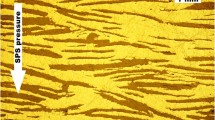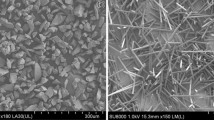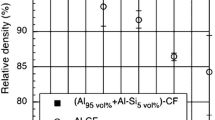Abstract
Light materials with high thermal conductivity and low thermal expansion have a wide application potential for the thermal management of high-performance electronics, in particular in mobile and aerospace applications. We present here metal matrix composites with a mixture of graphite flakes and pitch-based carbon fibres as filler. The production by spark plasma sintering orients the filler particles on to a plane perpendicular to the pressing axis. The obtained materials have lower density than aluminium combined with a thermal conductivity significantly outperforming the used metal matrix. Depending on the ratio of the filler components, a low thermal expansion along the pressing direction (high graphite flakes content) or across the pressing direction (high carbon fibre content) is achieved. For a 1:3 ratio of carbon fibres to graphite, we measured an isotropic reduction of the thermal expansion of the matrix by up to 55%. We present a detailed characterisation of composites with two aluminium alloys as matrix and an overview of the properties for six different metal matrices including magnesium and copper. With the goal of a technical application, we show that the described properties are intrinsic to the material compositions and are achieved with a wide spectrum of production methods.



Similar content being viewed by others
References
Carlson RO, Glascock HH, Webster HF, Neugebauer CA (1984) Thermal expansion mismatch in electronic packaging. In: MRS Proceedings, Cambridge University Press, p 177
Chung DDL (1995) Materials for electronic packaging. Butterworth-Heinemann, Woburn, MA
Rawal S (2001) Metal–matrix composites for space applications. JOM J Miner Met Mater Soc 53:14–17. https://doi.org/10.1007/s11837-001-0139-z
Cornie JA, Zhang S, Desberg R, Ryals M (2003) Discontinuous graphite reinforced aluminum, and copper alloys for high thermal conductivity-thermal expansion matched thermal management applications. Met Matrix Compos LLC 1:1–7
Chen JK, Huang IS (2013) Thermal properties of aluminum–graphite composites by powder metallurgy. Compos B Eng 44:698–703. https://doi.org/10.1016/j.compositesb.2012.01.083
Etter T, Papakyriacou M, Schulz P, Uggowitzer PJ (2003) Physical properties of graphite/aluminium composites produced by gas pressure infiltration method. Carbon N Y 41:1017–1024. https://doi.org/10.1016/S0008-6223(02)00448-7
Hutsch T, Schubert T, Schmidt J et al (2010) Innovative metal–graphite composites as thermally conducting materials. In: Proceedings Powder Metallurgy World Congress Exhibition PM2010, pp 361–368
Fukushima H (2010) High-thermal-conductivity graphite-particles-dispersed-composite and its production method. US Patent 7,851,055, 14 Dec 2010
Boden A, Boerner B, Kusch P et al (2014) Nanoplatelet size to control the alignment and thermal conductivity in copper–graphite composites. Nano Lett 14:3640–3644. https://doi.org/10.1021/nl501411g
Firkowska I, Boden A, Boerner B, Reich S (2015) The origin of high thermal conductivity and ultralow thermal expansion in copper–graphite composites. Nano Lett 15:4745–4751. https://doi.org/10.1021/acs.nanolett.5b01664
Oddone V, Boerner B, Reich S (2017) Composites of aluminum alloy and magnesium alloy with graphite showing low thermal expansion and high specific thermal conductivity. Sci Technol Adv Mater 18:180–186. https://doi.org/10.1080/14686996.2017.1286222
Bai H, Xue C, Lyu J et al (2018) Thermal conductivity and mechanical properties of flake graphite/Al composite with a SiC nano-layer on graphite surface. Compos A 106:42–51. https://doi.org/10.1016/j.matdes.2016.06.122
Korb G, Koráb J, Groboth G (1998) Thermal expansion behaviour of unidirectional carbon-fibre-reinforced copper–matrix composites. Compos A 29:1563–1567. https://doi.org/10.1016/S1359-835X(98)00066-9
Koráb J, Štefánik P, Kavecký Š et al (2002) Thermal conductivity of unidirectional copper matrix carbon fibre composites. Compos A 33:577–581. https://doi.org/10.1016/S1359-835X(02)00003-9
Silvain J-F, Veillère A, Lu Y (2014) Copper–carbon and aluminum–carbon composites fabricated by powder metallurgy processes. J Phys Conf Ser 525:12015. https://doi.org/10.1088/1742-6596/525/1/012015
Oddone V, Reich S (2017) Thermal properties of metal matrix composites with planar distribution of carbon fibres. Phys Status Solidi Rapid Res Lett 1700090:1700090. https://doi.org/10.1002/pssr.201700090
Jagannadham K (2011) Orientation dependence of thermal conductivity in copper–graphene composites. J Appl Phys 110:74901. https://doi.org/10.1063/1.3641640
Cho J, Chen JY, Daniel IM (2007) Mechanical enhancement of carbon fiber/epoxy composites by graphite nanoplatelet reinforcement. Scr Mater 56:685–688
Qin W, Vautard F, Drzal LT, Yu J (2015) Mechanical and electrical properties of carbon fiber composites with incorporation of graphene nanoplatelets at the fiber–matrix interphase. Compos B Eng 69:335–341
Thongruang W, Spontak RJ, Balik CM (2002) Correlated electrical conductivity and mechanical property analysis of high-density polyethylene filled with graphite and carbon fiber. Polymer (Guildf) 43:2279–2286
Prieto R, Molina JM, Narciso J, Louis E (2008) Fabrication and properties of graphite flakes/metal composites for thermal management applications. Scr Mater 59:11–14. https://doi.org/10.1016/j.scriptamat.2008.02.026
Dresselhaus M, Dresselhaus G, Eklund PC (1996) Science of fullerenes and carbon nanotubes: their properties and applications. Academic Press, Elsevier, London
Minus ML, Kumar S (2005) The processing, properties, and structure of carbon fibers. J Miner Met Mater Soc 57:52–58. https://doi.org/10.1007/s11837-005-0217-8
Muhammad WNAW, Sajuri Z, Mutoh Y, Miyashita Y (2011) Microstructure and mechanical properties of magnesium composites prepared by spark plasma sintering technology. J Alloys Compd 509:6021–6029. https://doi.org/10.1016/j.jallcom.2011.02.153
Zhou Y, Hirao K, Yamauchi Y, Kanzaki S (2003) Effects of heating rate and particle size on pulse electric current sintering of alumina. Scr Mater 48:1631–1636
Olevsky EA, Kandukuri S, Froyen L (2007) Consolidation enhancement in spark-plasma sintering: impact of high heating rates. J Appl Phys 102:114913
Munir ZA, Anselmi-Tamburini U, Ohyanagi M (2006) The effect of electric field and pressure on the synthesis and consolidation of materials: a review of the spark plasma sintering method. J Mater Sci 41:763–777. https://doi.org/10.1007/s10853-006-6555-2
Donaldson AB, Taylor RE (1975) Thermal diffusivity measurement by a radial heat flow method. J Appl Phys 46:4584–4589
Segl J, Edtmaier C, Rosenberg E (2016) Influence of processing parameters on the thermal conductivity behavior in Al-diamond MMCs. In: World PM2016, pp 1–7
Wolff M, Ebel T, Dahms M (2010) Sintering of magnesium. Adv Eng Mater 12:829–836. https://doi.org/10.1002/adem.201000038
Buerschaper RA (1944) Thermal and electrical conductivity of graphite and carbon at low temperatures. J Appl Phys 15:452–454
Zahra AM, Zahra CY, Jaroma-Weiland G et al (1995) Heat capacities of aluminium alloys. J Mater Sci 30:426–436. https://doi.org/10.1007/BF00354407
Mounet N, Marzari N (2004) High-accuracy first-principles determination of the structural, vibrational and thermodynamical properties of diamond, graphite, and derivatives. https://doi.org/10.1103/physrevb.71.205214
Ueno T, Yoshioka T, Ogawa J et al (2009) Highly thermal conductive metal/carbon composites by pulsed electric current sintering. Synth Met 159:2170–2172. https://doi.org/10.1016/j.synthmet.2009.10.006
Daoud A (2004) Wear performance of 2014 Al alloy reinforced with continuous carbon fibers manufactured by gas pressure infiltration. Mater Lett 58:3206–3213. https://doi.org/10.1016/j.matlet.2004.06.012
Kwon H, Estili M, Takagi K et al (2009) Combination of hot extrusion and spark plasma sintering for producing carbon nanotube reinforced aluminum matrix composites. Carbon N Y 47:570–577. https://doi.org/10.1016/j.carbon.2008.10.041
Etter T, Schulz P, Weber M et al (2007) Aluminium carbide formation in interpenetrating graphite/aluminium composites. Mater Sci Eng A 448:1–6. https://doi.org/10.1016/j.msea.2006.11.088
Monje IE, Louis E, Molina JM (2013) Optimizing thermal conductivity in gas-pressure infiltrated aluminum/diamond composites by precise processing control. Compos A Appl Sci Manuf 48:9–14. https://doi.org/10.1016/j.compositesa.2012.12.010
Acknowledgements
VO acknowledges the Evonik Foundation for the financial support. We acknowledge M. Wolff from the Helmoltz-Zentrum Geesthacht for providing the Mg–0.9Ca powders, Ecka Granules GmbH for the aluminium powders and the Nippon Graphite Fiber Corporation for the carbon fibres. We thank P. Leibner from the Max Planck Institute of Colloids and Interfaces for use of their equipment for tensile tests.
Author information
Authors and Affiliations
Corresponding author
Ethics declarations
Conflict of interest
The authors declare that they have no conflict of interest.
Electronic supplementary material
Below is the link to the electronic supplementary material.
Rights and permissions
About this article
Cite this article
Oddone, V., Segl, J., Prakasam, M. et al. Isotropic thermal expansion in anisotropic thermal management composites filled with carbon fibres and graphite. J Mater Sci 53, 10910–10919 (2018). https://doi.org/10.1007/s10853-018-2373-6
Received:
Accepted:
Published:
Issue Date:
DOI: https://doi.org/10.1007/s10853-018-2373-6




